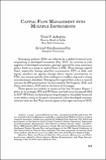| dc.contributor.author | Acharya Viral V. | |
| dc.contributor.author | Krishnamurthy, Arvind | |
| dc.date.accessioned | 2019-11-01T00:08:27Z | |
| dc.date.available | 2019-11-01T00:08:27Z | |
| dc.date.issued | 2019 | |
| dc.identifier.isbn | 978-956-7421-60-2 | |
| dc.identifier.uri | https://hdl.handle.net/20.500.12580/3869 | |
| dc.description | Emerging markets (EMs) are affected by a global financial cycle originating in developed economies (Rey 2013). An increase in risk appetite of developed economies perhaps spurred by easy monetary policy leads to a surge in capital flows to EMs. These foreign capital flows especially foreign portfolio investments (FPI) in debt and equity markets (as against foreign direct equity investments or FDI) can reverse quickly thus leading to a sudden stop and a sharp macroeconomic slowdown. Managing this capital flow cycle is a central concern for EM governments (as discussed by De Gregorio 2010 and Ostry and others 2010) and is the focus of this paper. | |
| dc.format | .pdf | |
| dc.format.extent | Sección o Parte de un Documento | |
| dc.format.medium | p. 169-203 | |
| dc.language.iso | eng | |
| dc.publisher | Banco Central de Chile | |
| dc.relation.ispartof | Series on Central Banking Analysis and Economic Policies no. 26 | |
| dc.rights | Attribution-NonCommercial-NoDerivs 3.0 Chile | * |
| dc.rights.uri | http://creativecommons.org/licenses/by-nc-nd/3.0/cl/ | * |
| dc.subject | MOVIMIENTOS DE CAPITAL | es_ES |
| dc.subject | INSTRUMENTOS FINANCIEROS | es_ES |
| dc.subject | POLÍTICA MONETARIA | es_ES |
| dc.title | Capital flow management with multiple instruments | |
| dc.type.doc | Artículo | |
| dc.file.name | BCCh-sbc-v26-p169_203 | |


